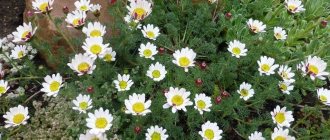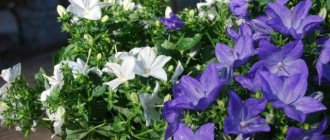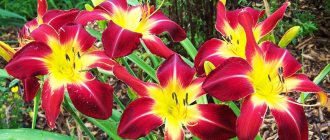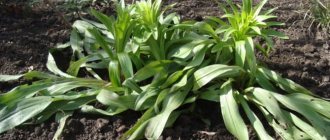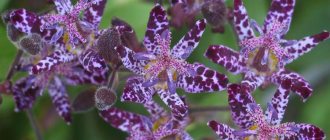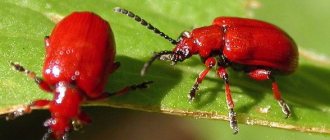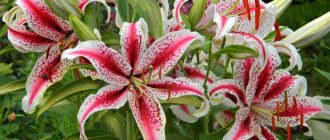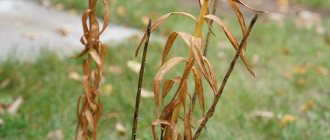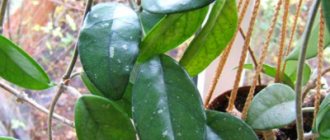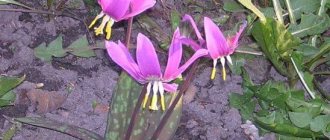- October 11, 2019
- Flowers
- Victoria Litvinova
Lilies are very popular among gardeners from all over the world. They are very delicate and beautiful, which is why they are widely recognized as decorative flowers. They are grown separately, they are used to create various compositions, and lush bouquets are collected from them... There are a considerable number of other plants that look very much like lilies. What kind of flowers are there that look like lilies? You will learn about this from our article.
A little about lilies
These are graceful flowers that have been highly valued by lovers of beauty since ancient times. They embody purity and beauty. White lilies were considered a symbol of purity, and the ancient Romans and Greeks believed that they personified Juno and the goddess Hera.
Lilies are bulbous perennials. The stem reaches a height of 15 to 250 cm. It is covered with bright green leaves. The inflorescences are brushes in the shape of an umbrella, cylinder or cone. On average, each brush contains from 8 to 16 flowers, but sometimes their number reaches 30 pieces. The flowers bloom in a specific order, from those at the bottom to those at the top of the stem.
They consist of 6 petals, which are arranged in two rows. In the center, where the petals meet, are the stamens. The shape of the flowers can be any: turban-shaped, star-shaped, bell-shaped or funnel-shaped. The palette is very rich. There are soft pink, snow-white, yellow, apricot, and dark purple lilies. The petals may have specks, spots or a border. There are even two-color lilies. But despite all this, there are no blue flowers.
You have read a brief description of the plant. Now we will tell you what flowers similar to lilies exist (including indoor varieties).
Watsonia
Watsonia, or Watsonia, is a bulbous plant. Exotic flowers belonging to the iris family grow in southern Africa. They look very impressive: on straight stems, the length of which reaches two meters, there are pointed leaves of bright green color and exquisite flowers. They are tubular in shape and resemble both lilies and gladioli in appearance. Lily-like flowers come in a variety of colors and can be orange, red or pink. They bloom throughout the summer. They are not very picky in their care, which gardeners cannot but like.
Goose onion
The flower that bears this name belongs to the lily family. The homeland of the herbaceous honey plant is North Africa. Currently, there are at least 10 varieties of this culture, each of which has unique characteristics. The plant blooms very early, which is why it is popularly called the yellow snowdrop.
The goose onion flower has a pleasant appearance. Each inflorescence consists of a dozen soft yellow buds. They are shaped like stars, although very small. The bright petals are green on the back. The buds are located on low stems. The leaves are elongated and neat.
Perennial plants are light-loving; they are grown in fertile, loose soil. Goose onion fully opens its petals only in sunny weather. On cloudy and rainy days, the buds close tightly, making the flower almost invisible among the green leaves.
Flowers from the Liliaceae family that look like lilies
More than 4 thousand different varieties and species include Liliaceae. They are distinguished by symmetrical flowers, often with 6 petals. Representatives of this species are grasses, bushes and even trees. Their most famous representatives are tulips. In addition to them, there are lesser-known but popular flowers similar to lilies.
It will also be interesting: Plants of the Liliaceae family - representatives and description of flowers ⚜
Goose onion
A small lily flower that grows in steppes and forests, as well as on mountain slopes and semi-deserts, is often called the yellow snowdrop. This is a low-growing herbaceous plant. Just like the lily, it belongs to the bulbous family. Goose onion blooms quite early, its buds bloom in early April. On a stem no more than 35 cm high, 6 small star-shaped yellow flowers grow.
Goose onion
On the outside, the petals have a delicate green color. In cloudy and rainy weather, the buds close completely, and the daylily becomes almost invisible. When the plant fades, a fruit forms on the stem in the form of a spherical box with seeds. Only one long green leaf grows from the bulb.
Cardiocrinum
A representative of the lily family, the peculiarity of which is its very high growth, which can reach 5 meters. For this reason, it is usually classified as a giant Liliaceae. Translated from Greek, Cardiocrinum means “heart-shaped lily.” This name is associated with the shape of the leaves of the flower, which resembles a heart.
Cardiocrinum
The flowering period most often occurs in mid-summer, when a large number of large narrow funnel buds with a strong pleasant aroma bloom at the top of the flower. Such lush flowering completely exhausts the bulb, which, leaving daughter bulbs, dies. This spectacular plant is a real decoration of the garden. In nature, it grows in Asian countries.
Tritsirtis
This flower is often called the garden orchid and toad lily. This rather beautiful plant, belonging to the Liliaceae family, is unpretentious and hardy. The flowers are funnel-shaped or bell-shaped, with small inclusions on the petals, of which, as a rule, there are no more than six. Outwardly similar to both orchids and lilies.
Tritsirtis
It has long been noticed that Tritsirtis emits a smell that attracts frogs. The Filipinos used this feature of the flower to hunt for edible frogs. Now Tritsirtis is often used to decorate flower beds, as well as houses, grown in pots.
Kandyk
A bulbous perennial plant whose height does not exceed 45 cm. Its natural habitat is the Caucasus Mountains and North America. At the beginning of spring, from a bulb sitting deep in the ground, oblong, ovoid, bluish-gray leaves with green spots sprout. Then drooping flowers of a wide variety of colors bloom on a thin stem. By early summer they fade.
Kandyk
In general, a rather unpretentious plant that does not require special care is an excellent addition to other bulbous flowers. Grows best in shaded areas. Requires regular, not too abundant watering.
It will also be interesting: Diseases and pests of lilies - why they don’t bloom, fight and treatment ⚜
Hippeastrum
These lily-like flowers are shaped like stars. There are a large number of varieties of hippeastrum, and each variety has its own characteristics: the shape of the buds, aroma, color - all this differs among representatives of different varieties.
2 arrows sprout from the bulbs, on which there are up to 6 buds. When they bloom, they reach a diameter of 20 cm. Large flowers can have a variety of colors, from soft white to bright red. The petals sometimes have a contrasting border, strokes or stripes. Since the plant is native to South Africa, in temperate climates it is cultivated only as a houseplant.
Water
She is also a water lily or nymph. A variety of Lilies that grows in water - in garden plots it is grown in decorative ponds. Round, wide leaves float on its surface, and the flowers are located on very long stems, which bring them to the surface.
Flower growers prefer to grow winter-hardy varieties, these include the following representatives of water lilies:
Fragrant water lily. Prefers a depth of 40 to 80 cm. The flowers are pink or white and have a bright aroma.
Read also: What does peeled pumpkin mean?
The white water lily blooms with flowers up to 15 cm in diameter. Despite the name, varieties of the variety can have flowers of a creamy, pink or even red hue. This variety is capable of growing at a depth of half a meter to 2.5 meters.
The tetrahedral water lily has small flowers up to 5 cm in diameter. They are painted white or pink, sometimes the bottom of the white petals is pink. The base of the cup has a quadrangular shape, the corners are bent down.
Kandyk
Another plant that cannot be ignored is the kandyk flower. Translated from ancient Greek, the name means “red”. The culture is popularly known as “dog fang” because the flower bulbs have an unusual shape. The stems are oblong, but not too tall. The kandyk flower decorates the environment in early spring. The buds can be pink, white, purple or yellow. In the wild, the crop grows in mountainous areas. It is very popular among landscape designers.
Cardiocrinum
This plant belongs to the same family as lilies. People even called it “heart-shaped lily”, because the shape of the leaves really resembles a heart. During the flowering period, cardiocrinum changes its color several times. The lily-like flowers are bronze at first, then become olive red before turning dark green.
They are tall: the stems reach a length of 2 meters, but there are also cases when they grew up to 5 meters. There are lush rosettes of leaves on the even stem, and in the middle of summer, inflorescences resembling brushes appear on it. Each of them blooms from 5 to 30 flowers, which have a stunning aroma. The plant is used to decorate gardens.
Alstroemeria care
The general rules of care are not fundamentally different from caring for other garden flowers; they are as follows:
- in weed removal
- in timely watering
- in fertilizing
- pest protection
- in disease prevention
It is much more important to preserve the plant in winter, especially for young seedlings in the first years after planting. Although it is traditionally believed that many varieties can withstand frosts down to -20, the plant still needs protection from low temperatures. During the autumn period, you need to do the following:
- shorten the ground parts to 5 - 7 cm
- add a layer of sawdust or leaves
- lay the spruce branches
- cover with a piece of roofing felt
You can do with young flowers as they sometimes do with chrysanthemums, that is, dig them up and place them in a room with a temperature no lower than + 1 and no higher than + 6. If everything is done correctly, the Peruvian lily will not only be a decoration in the garden, but also its bouquets will decorate your home.
Video about alstroemeria:
Tritsirtis
It is impossible not to talk about this herbaceous perennial. Tricyrtis flowers were first found in East Asia, but have won the recognition of gardeners from all over the world. In the Philippines, the plant is known as the "toad lily" because its distinctive scent attracts edible frogs. In Europe, it was given a different name: garden orchid - for its similarity with this culture.
The flowers are large and can grow singly or in bunches. Sometimes they “hide” in dense foliage. The stems are long, they can reach a length of 1.5 m. As for the color, it can be white, cream or yellow. Often the petals are spotted, which makes the plant almost a copy of the lily. Their shape is bell-shaped or funnel-shaped. Tritsirtis can be grown in flower beds and in pots, because it is unpretentious and hardy.
White lily hybrids
European snow white lily hybrids were obtained by crossing L. Candidum, L. Testaceum, L. Chalcedonicum. Hybrid varieties have white perianth, flowers up to 13 cm in size, and they have a wonderful aroma. The perianth is tubular or funnel-shaped. The length of the stems is up to 1.5 m. They are densely covered with leaves. The leaves are narrow, lanceolate, dark green. The varieties bred through selection are still capricious. They need to be well covered for the winter, they are heat-loving, do not like shade, and they always need protection from fungal diseases.
The best varieties that are grown in Russian flower beds.
Apollo hybrid. It reaches a length of up to 1.2 m. The flowers are snow-white, with a pleasant aroma, and there are small dark dots in their middle. Flowering occurs in the second and third summer months.
Hybrid Madonna. The flower resembles a pipe with slightly curved edges. The flower is snow-white, its size is up to 13 cm, and has a delicate aroma.
Hesperocallis
This culture is also included in the list of flowers that look like lilies. The Hesperocallis flower is a member of the Asparagus family, but it is quite rare. It grows in dry areas, such as deserts. The stems are thick and straight, their height often exceeds one and a half meters. Reproduction occurs using bulbs. The flowers are large and beautiful, their colors vary from silver-white to greenish. Hesperocallis blooms only after precipitation falls in deserts. The buds open in the evening, before sunset, and at these moments they exude a strong, incomparable aroma.
What does alstroemeria symbolize in the language of flowers?
In the Victorian era, when there was a fashion for composing messages using bouquets, alstroemeria was not popular. But flower lovers still endowed it with a special meaning. This is the flower of friendship. It does not have a romantic connotation, but denotes friendly and friendly relationships.
Depending on the shade of the buds, even friendship can be said in different words:
- White alstroemeria signifies spiritual kinship and intimacy.
- Pink - the desire to care and help a friend.
- Purple, lilac and blue emphasize the individuality and uniqueness of the recipient.
- Yellow and orange bouquets are given to wish success and prosperity.
- Even red flowers are presented not as a declaration of love, but as a sign of warmth and affection.
People who believe in omens believe that alstroemeria should be kept at home to attract friends. You can limit yourself to a bouquet or buy a plant in a pot.
If you want to change the message and make it more romantic, order designer bouquets of different flowers. In the article “ What are alstroemerias combined with in a bouquet: photos and descriptions of compositions
“We told you what incredible ensembles florists put together with this wonderful flower.
Worsley
This plant is known as blue amaryllis. It has received great recognition throughout the world due to its unusual colors. They are ultramarine or blue. In the wild, Worsleya is found in tropical latitudes, for example, in eastern Brazil. In this region they reach a height of several meters, and the leaves grow to 90 cm or more.
At the tops of the long stems there are about 15 funnel-shaped buds with a diameter of 15 cm. In the natural environment, flowers on thick stems, similar to lilies, delight the eye with their beauty throughout the year. At home, flowering occurs in the summer. The plant is whimsical and must be carefully looked after. Experienced gardeners are engaged in growing vorsley, because the flower is very demanding of environmental conditions.
Flowers from the Amaryllis family, most similar to lilies
A family of more than 70 species of flowers around the globe. Many members of this family are quite well-known: for example, white snowdrop or narcissus. The unpretentiousness and hardiness of most plants allow them to be grown both at home and in a flower bed.
Often these are perennial flowers that practically do not require replanting. Almost all Amaryllis are classified as bulbous, but there are corm varieties of flowers. They bloom in bisexual inflorescences collected in umbrellas or racemes; single flowering is rarely possible. The leaves of the flowers are most often sessile, collected in a ground rosette, in a double-row, alternate arrangement.
A special feature of the family are incredibly beautiful flowers of various shapes and colors. They often bloom simultaneously, collected in a tassel or basket. Sometimes there is one, but quite large, flower on the stem. To attract insects, flowers emit a strong aroma and produce large amounts of nectar. The most incredible shapes and magnificent flowers have made amaryllis quite popular among flower growers around the world.
Amaryllis
Amaryllis, or belladonna lily, is a bulbous flower native to South Africa. Most often in natural conditions it can be found in rocky areas on the banks of rivers and streams. This is a plant of medium height, with one, rarely two stems approximately 60 cm in height. Each of them can bear up to 12 funnel-shaped flowers, each about 12 cm in diameter.
The most common flowers are white, purple and pink, which can be decorated with crimson veins on the petals. Flowers reproduce by rather large, heavy seeds - due to the fact that the wind cannot carry them over a long distance, they most often grow in groups.
Amaryllis
The flowering period is the end of summer, February and March, after which the flower begins a dormant period, during which it needs as little water as possible. A fairly heat-loving plant, it does not tolerate frost very well, so in our climate it requires special care with germination in greenhouse conditions.
The most famous representative of this species, amaryllis belladonna, is grown only as a houseplant.
Hippeastrum
The star-shaped flower is often mistaken for a lily. There are a large number of varieties of this flower, which differ in the shape of the buds, color, smell, and care characteristics. From each planted bulb, 1-2 long arrows grow, on which up to 6 buds are tied.
Hippeastrum
Once in bloom, they can reach a diameter of about 20 cm. The color of the flowers varies from soft white to bright red. The petals can be decorated with a border of a contrasting color or various strokes and stripes.
Most often, flowering begins in late winter or early spring and can continue until the end of May. Originally from South Africa, in cold and temperate climates it can only grow as a houseplant.
Vallota the Beautiful
A deciduous bulbous plant native to southern Africa - quite light-loving and heat-loving. During the period of active growth, a stem with a height of 10 to 60 cm grows from the bulb, on which up to 5 bell-shaped or funnel-shaped large flowers bloom. The most common plants are those with purple flowers, but there are varieties with pink, white and salmon-colored petals.
Vallota the Beautiful
A distinctive feature of the flower is the rich purple color at the base of the oblong (about 40 cm) leaves, which are collected in one rosette and resemble a fan. In temperate climates, growing outdoors is not possible, but it can be grown quite successfully as a houseplant.
Narcissus
Perhaps one of the most famous representatives of amaryllis is the narcissus. This is a perennial bulbous plant that does not require replanting for 5-8 years. There are more than 60 species of this flower in the world. Widely distributed throughout the world, but most often it can be found in mountain deciduous forests and meadows. Due to its rather early flowering, it can be classified as a primrose. Under normal weather conditions, the first buds may bloom in early April. The downside is that it fades quite quickly.
Narcissus
From the bulb grows several long arrow-shaped leaves about 30 cm high and a stem with one bud, which is formed by 6 petals. Growing together at the base, the petals form a crown. The petals and crown can be white, yellow, or less often orange. A fairly hardy and unpretentious plant that practically does not require special conditions, it is most often grown outdoors, but indoor varieties are also found.
Eucharis
An incredibly durable and delicate plant belongs to the bulbous flowers. On a fairly tall peduncle, up to 6 white buds, each about 12 cm in diameter, can bloom. Bell-shaped and funnel-shaped flowers have a fairly long corolla tube, which is why the bud hangs down. With proper care, Eucharis can bloom 2 times a year - at the very beginning of spring and late autumn.
Eucharis
Thanks to its unusual massive and wide elongated leaves, the plant is valuable not only during the flowering period, but also during dormancy. It requires heat, and therefore in our conditions it is grown only at home.
Zephyranthes
A herbaceous perennial bulbous plant approximately 20 cm high. Its feature is the rapid germination of a peduncle stem with opening buds. For the stems that jump out of the ground, it is often called “upstart”. The inflorescences are star-shaped, somewhat similar to crocuses, with petals of all shades of yellow, pink and, less commonly, white.
Zephyranthes
After the flowers, long, wide leaves sprout. This plant requires large amounts of sunlight for normal growth and flowering. Most often it blooms twice a year - in summer and winter. Many gardeners grow it indoors.
Worsley
Often called the Blue Amaryllis, the flower is prized for its unusual flowers in all shades of ultramarine and blue. Its natural habitat is tropical forests in eastern Brazil. There, the growth of Worsleya (together with flowers) can reach several meters, and the leaves themselves grow to at least 90 cm.
Worsley
At the top of the stem, up to 15 elongated funnel-shaped buds are collected, the diameter of which is on average 15 cm. At home, flowering occurs more often in the summer; in the natural environment it can occur all year round. A rather whimsical plant that requires special and careful care. Does not tolerate a lack of sun, needs proper soil and regular fertilizing, strictly dosed watering.
It will also be interesting: Lily Pretty Woman - description and care at home?
Licorice
Another more interesting plant, which has a number of similarities with lilies, is called lycoris. It grows in Asian countries such as Japan, China and Korea. The flower is popularly known as the spider lily. Licorice is grown quite rarely in Russia, but in China everyone knows about it. For example, over many years of cultivation, local flower growers noticed one interesting feature of lycoris: its leaves and flowers appear at different times. Because of this, it is called "san cho", which translates as "leaves missing flowers, and flowers missing leaves."
The bulbs are very large, they are 15 times larger than those of tulips. In spring, powerful leaves appear that make the plant look like a daffodil. For a whole month you will be looking forward to the flowers appearing, but... the leaves will die, and flowering will not begin. Only in September will you discover incredibly beautiful flowers. Individually, each flower lives for 3-4 days, and the flowering process itself lasts a little more than 2 weeks.
The appearance of the flowers is unusual: the petals are wavy, the stamens are very long, the color can be pink, purple or lilac. Lycoris has a pleasant smell. The plant has found application in landscape design. It is used in group plantings and cultivated under deciduous trees and in mixborders. In addition, bouquets are made from it.
White lily: planting in open soil
Choosing a landing site is as easy as shelling pears. Pure varieties will do well in light shade or in an area that is open and gets plenty of sun. Hybrids need to be grown in places where there is always sun.
There should be no dense bushes around the circumference of the landing site. Shrubs create an overly moist environment around flowers and shield them from light.
The soil for planting must be loose, fertile, alkaline, not acidic (the plant will get sick or die in it). You can remove the acid by adding lime; lilies like it. If you are going to plant lilies in heavy clay soil, then before planting you need to add sand to the soil and create a drainage system.
The best time for planting is the first autumn days. The lily has time to gather leaves at the roots and get used to the winter season. If you plant a lily in the spring, the flower will get sick and may not bloom at all. After the lily has bloomed, it rests. The aerial part dies off and the bulbs are dug up for replanting or further propagation. But! If the bulbs have already begun to form a rosette, then there is no need to dig them up.
Prepare the seating area in advance. The soil is dug up, weeds are removed, if necessary, sand and fertilizers are added (a bucket of humus, 100 g of superphosphate, 50 g of potassium sulfate, ½ kg of ash per 1 m2 area) to lighten the soil. Then water the area with a large volume of water.
When planting bulbs, there is no need to bury them. Plant 10-12 cm deep. If planted in loose soil, then you can deepen the bulb; if in heavy soil, then plant it higher than 10-12 cm.
But in any case, it is necessary to plant so that a 3 cm soil layer remains above the bulb, taking into account the size of the bulb. The interval between the bulbs is at least 26 cm. When planting, you can put a support for the stems in the hole to determine the planting location while the flower is at the dormant stage.
Day-lily
This herbaceous plant comes from East Asia. To be more precise, the culture is called yellow daylily. By the name, you can immediately guess two things: firstly, the flowers look like lilies, and secondly, their color is bright yellow, even lemon.
The scientific name, which sounds “hemerocallis” and translates as “one-day beauty,” reflects the striking feature of this plant: it blooms only for one day.
You can meet yellow daylily in the wild only in Central China. The bushes reach a height of 1 meter and are branched. Large flowers are located on long peduncles, from which a pleasant smell emanates.
Narcissus
This representative of the amaryllis family is a bulbous plant that is relatively unpretentious. There are at least 60 varieties of this perennial. Daffodils are widespread almost everywhere; they can be grown both in the garden and indoors. If you properly care for the flowers, the first buds will bloom in early April.
The stem with one bud is surrounded by arrow-shaped leaves, the length of which is 30 cm. Each flower consists of 6 petals fused at the base. They form the so-called crown. The color of the buds can be white, yellow or even orange.
Vallota
Another amazing plant grows in African countries, and now we are talking about such a flower as the beautiful wallot. The flower is intended for growing at home. The perennial is very prolific and unpretentious, so you can achieve abundant flowering even in a cramped pot and in uncomfortable environmental conditions.
This representative of the flora has a small bulb and narrow, long leaves. It is characterized by white, pink, purple and red colors. The shape of the flowers is bell-shaped or funnel-shaped. The leaves are purple at the base, they form rosettes and resemble a fan.
Alstroemeria
Lily-like flowers are considered close relatives of this plant. Another name for them sounds like “Peruvian lily”. The flower is very miniature and can have a variety of colors. The inside of the petals is covered with specks. Alstroemerias can be white, purple, burgundy and yellow, and sometimes bicolored plants are also found. An interesting fact is that in stores they are often called orchids, but this, of course, is not true, because they have very little resemblance to these representatives of the flora.
In ancient times, the plant was worshiped by peasants. The Incas, who took the first steps in the fields of medicine, architecture, and sculpture, believed in natural forces. They especially singled out alstroemeria, because they believed that it was a gift from the solar deity. There are many interesting legends about this plant. The flower was believed to have magical properties. For example, representatives of ancient civilizations believed that alstroemeria could make a person invisible and even turn him into an animal.
Amaryllis
Despite the fact that the amaryllis flower is unknown to domestic gardeners, it should be talked about. The plant, which is native to South Africa, is moisture-loving, so it is often found on the banks of streams and rivers. A variety of belladonna is grown at home, but it requires careful care.
The flower can grow up to 70 cm. The long stem has half-meter-long leaves. Up to 12 funnel-shaped flowers bloom on each of these stems. Their diameter is at least 12 cm. The bulb is pear-shaped, it shoots several arrows of different shades. The amaryllis flower consists of red, purple, white and pink petals, there are always 6 of them. Because the seeds are heavy and large, amaryllis grow in groups.
Diseases and pests
Despite its rather fragile appearance, alstroemeria is quite resistant to pests and diseases. First of all, the humidity regime will require attention - if the soil drainage is insufficient or the air is highly humid (for example, there is a body of water nearby), then alstroemeria is often affected by botrytis (grey mold). Therefore, after long, prolonged rains, the rhizomes and the entire plant must be treated with a solution of foundationazole (or another fungicide analogue). Repeated treatment is carried out after 2-3 weeks.
The main pests that attack alstroemeria are: thrips, slugs, spider mites, leaf-eating beetles and caterpillars. For the prevention and control of them, drugs such as actara, actellik, fitoverm, karbofos and others are effective.
When cutting alstroemeria, be sure to remove the bottom third of the leaves. It should be cut at the stage of bud emergence.
Hyacinth
This bulbous plant is very popular. It is considered a primrose, because colorful inflorescences appear in early spring. It can be cultivated in gardens, flower beds, and at home, in pots. The advantage of hyacinths is that they are unpretentious. The main condition that must be observed when growing them is constant access to oxygen. Therefore, you need to regularly ventilate the room or even take the pot out onto the balcony. Flowering begins when the temperature rises just above 15 ° C.
On average, flowers grow up to 40 cm. Fleshy and wide stems grow from the bulb. They are surrounded by narrowed long leaves. The buds bloom throughout the entire peduncle, starting from the bottom and ending at the top. The flowers are very similar to lilies, only they are small and collected in brushes. The variety of the palette is amazing: the color can be soft pink, white, yellow, crimson, blue or even dark blue, and these are not all possible shades! The plant emits a pleasant, persistent aroma.
Indoor flowers blooming with white flowers
The beautiful white inflorescences of the Royal Phalaenopsis Orchid reign in home greenhouses. Orchids Vanda, Multiflora, Mini and Midi, Butterfly, White Heron, Amabilis are white-flowering plants.
Many people know the perennial flower Campanula under the name “Bride”. Its white flowers are collected in clusters, and round, jagged leaves grow on soft green stems.
The original indoor flower that gives women happiness is called Spathiphyllum. At the top of a short peduncle, next to the opening petal, an elongated ear grows in the form of a white sail.
Grandmothers' favorite flowers are geraniums, which live on many windowsills and are now called Pelargoniums. Geraniums are plants with small simple flowers that grow in the open air in summer in natural conditions. But the beauties of Pelargonium bloom their white double inflorescences all year round.
Tuberous white Tuberose, planted in a pot, when flowering, emits aromas that combine shades of jasmine, lily, lily of the valley, and lemon.
White varieties of Saintpaulia - terry, simple, rose-like, together with Impatiens, create a floral paradise on the windowsill.
Gardenia jasmine bushes with flowers collected in inflorescences reminiscent of a blooming rose require special care. But the beauty of these bushes forces housewives to carefully regulate the temperature and light conditions, take care of the nutritional value of the soil and timely replanting, as long as this plant is in the home flower garden.
Flowers with snow-white petals evoke a feeling of tenderness, make you relax, think about the good, pure and beautiful. Plants planted in the garden with flowers and leaves of white shades convince that it is better to live calmly and dream than to think about bad things.
And this is so important now, in our troubled times.
There are trees that I also want to note. Of course, not everyone will plant them in the garden, but during flowering they will bring joy both in appearance and smell. This is an ordinary white acacia. Which, in addition to aesthetic pleasure, also has rich medical functionality.
Eucharis
This plant is also a bulbous plant. Its homeland is considered to be the Amazon and the foothills of the Andes. One of its names sounds like “Amazon lily,” but this is not entirely true, because the flower has more similarities with daffodils than with lilies. The plant is persistent and very tender. Several buds bloom on tall peduncles, reaching 12 cm in diameter. They hang down because the corolla tube is long.
The buds are snow-white and large, and inside the corolla there is a yellow-green crown. Translated from ancient Greek, the name of this fragrant plant means “full of charm.” Indeed, the tenderness and pleasant appearance have made the flower popular in interior design.
However, the beauty of eucharis is deceptive: beautiful in appearance, it can harm a person, since the poison contained in it causes kidney problems, vomiting and dyspepsia. Therefore, only experienced gardeners undertake to grow it. However, with proper care, the plant will delight you with abundant flowering twice a year.
From our article you learned the names of flowers that look like lilies, and also became familiar with their characteristics. As you can see, there are many representatives of the fauna that are in no way inferior in beauty to lilies. Which of the listed plants did you like best? Share your opinion in the comments.
